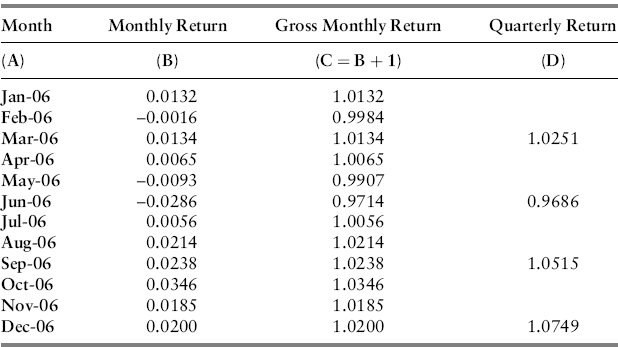Caveats to Return Extrapolation
Practitioners prefer to compare annualized returns and therefore extrapolate higher frequency returns (daily, monthly, and quarterly) to annual frequency. This practice, though common, can be misleading and it is important to know why. Consider the set of monthly returns to the S&P 500 index given in Table 1.3. The returns are for the year 2006.
Table 1.3 Monthly S&P 500 Returns.

We can geometrically link these monthly returns to get an annualized return, which is computed by taking the product of the gross monthly returns in column C and subtracting one, yielding 12.23 percent. This is the return that you would have received had you held the index for those 12 months. The table also geometrically links monthly returns to estimate quarterly returns, which are given in column D of the table. These quarterly returns are then geometrically linked by taking their product (and subtracting one) to get an annual return, also equal to 12.23 percent.
Now imagine that it is April 1, 2006, and having just observed the March return, we estimate the first-quarter return for 2006 at 2.51 percent. Your supervisor wants to know what this is on an annualized basis. In response, you compute ![]() , which upon substitution, computes to
, which upon substitution, computes to ![]() percent. What you have done is extrapolate a higher frequency return (quarterly) to a lower frequency estimate (annual). The implicit assumption in extrapolation is that the return observed for the period just realized (first quarter 2006) will hold for the remaining three quarters. (This is what is referred to as a naïve forecast). In general, this will not be the case and the extrapolated return will therefore most likely contain errors. In the example given, you can readily see the error embodied in each of these quarterly extrapolations by comparing them to the true observed annual return in column C.
percent. What you have done is extrapolate a higher frequency return (quarterly) to a lower frequency estimate (annual). The implicit assumption in extrapolation is that the return observed for the period just realized (first quarter 2006) will hold for the remaining three quarters. (This is what is referred to as a naïve forecast). In general, this will not be the case and the extrapolated return will therefore most likely contain errors. In the example given, you can readily see the error embodied in each of these quarterly extrapolations by comparing them to the true observed annual return in column C.
It is also important to realize that extrapolation generates more measurement error the greater the difference in the frequencies we extrapolate between. For example, if we extrapolate the monthly returns, that is, ![]() , then clearly, a single extraordinary monthly return will translate into an even more extraordinary annual return. Practitioners seem to know this and that is why higher frequency returns (weekly or daily) are generally never annualized. Returns are random. Extrapolation is not. The greater the difference between the frequencies we extrapolate between, the less we believe in randomness and the more we believe that the current observation portends all future observations. We are all most certainly aware of this problem but, nevertheless, we continue to extrapolate. It is important to remind ourselves and our colleagues of the weaknesses in these numbers.
, then clearly, a single extraordinary monthly return will translate into an even more extraordinary annual return. Practitioners seem to know this and that is why higher frequency returns (weekly or daily) are generally never annualized. Returns are random. Extrapolation is not. The greater the difference between the frequencies we extrapolate between, the less we believe in randomness and the more we believe that the current observation portends all future observations. We are all most certainly aware of this problem but, nevertheless, we continue to extrapolate. It is important to remind ourselves and our colleagues of the weaknesses in these numbers.
